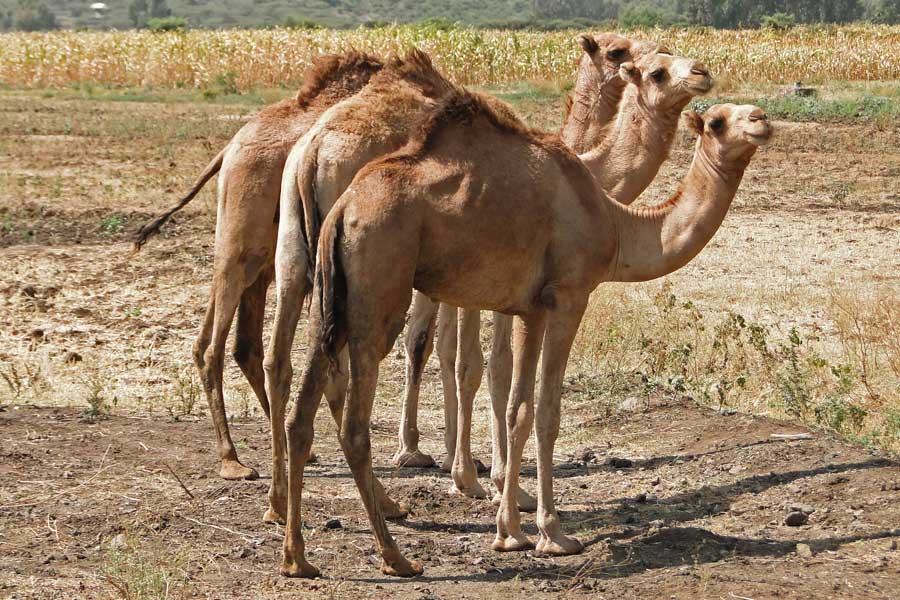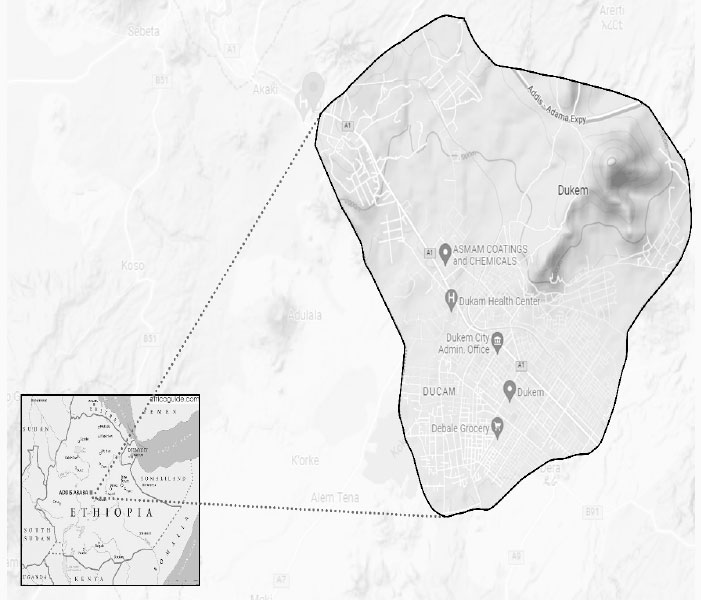
Fortune News | Feb 04,2023
On a Friday afternoon, April 24, 2020, the bodies of two individuals, 19 and 45, were discovered in Hamdael area, Dire Dawa City, following a flood caused by heavy rainfall. The bodies were found by local residents a kilometre away from their homes, swept downstream. The flash flood, which also took the lives of two children, ages four and two months, left six people injured and close to 500 households displaced in a day.
The flood has exposed over 2,000 families to food shortages in the area and destroyed close to one million Birr worth of property. Destruction of varying levels was caused to over 250 houses, power poles and water pipes. Out of the nine kebeles, eight were struck by the flood.
So far, Dire Dawa’s Disaster Risk Management Coordination Office has distributed materials worth 600,000 Birr, including clothes, sanitiser, and mattresses, and food items that cost about 700,000 Br to the victims, according to Harbi Bouh, head of the Office.
Vulnerable households are being evacuated, and people are taking shelter with their neighbours. The city is collecting funds to buy housing materials for the victims, according to Abdurrahman Birre, administrator of Kebele 09, where seven houses were completely destroyed and 60 houses partially ruined.
This is not unique to the administrative state of Dire Dawa. Regional states like Harari, Southern Nations Nationalities & People (SNNPR), Somali and Oromia have also been experiencing flash floods following heavy rainfall.
In the past month of April alone, flooding and landslides affected 220,000 people, and close to 110,000 people have been displaced in the Southern, Somali and Afar regional states, as well as Dire Dawa.
In Godere Wereda, Gambela Regional State, over a million trees have been destroyed by a flash flood after heavy rainfall that came down for two and a half consecutive hours on May 10, 2020, according to Udol Aguwa, head of the Gambela Regional State Government Press Secretariat.
The loss of human life and property damage has been an inescapable element in most of the regions.
The Southern Nations, Nationalities, & People’s Regional State has experienced extensive rainfall that has resulted in the loss of human life and damage to property. In Jinka town, a heavy flood that overflowed the Neri River inflicted damage on infrastructure and crops and swept away livestock. A few days later, the same town flooded leaving 20 houses razed, 84 households displaced, and 1,430ha of crops and crop fields destroyed.
Two people lost their lives and two more were injured in a landslide in Gacho Baba and Geresse Weredas in the Gamo Zone on April 11, 2020. Consequently, 33 livestock died, 52 houses were destroyed, 305 households were displaced, and 481 households with about 3,000 family members were left in urgent need of humanitarian assistance.
The flood has exposed over 2,000 families to food shortages in Dire Dawa.
On May 28, 10 people died in Gamo Zone, Gacho Baba Wereda, because of a landslide that followed heavy rainfall and a flash flood.
Over the past two months, flood accidents have become a headache for the country while it battles the spread of the Novel Coronavirus (COVID-19).
Seasonal flooding in April and May has so far affected 470,163 people, of whom some 301,284 people are displaced in Somali, Oromia, Afar, SNNP and Harari regional states as well as Dire Dawa City Administration, according to a report from the United Nations Office for the Coordination of Humanitarian Affairs (UN-OCHA).
"The situation is particularly severe in the Somali Regional State where more than 79pc of the flood-affected and displaced people are located," reads the report.
The unprecedented heavy rainfalls during the last winter season, from December throughout February, is due to the ever-increasing warming of the northwestern Indian Ocean and positive Indian Ocean Dipole (IOD), according to reports from the National Meteorology Agency.
Heavy rainfall ravaged the West Guji Zone, Oromia Regional State, on May 15, 2020, causing the death of three people and 40 million Br in damages. The flash flood displaced 63,000 families and affected close to 9,000 households.
These kinds of natural disasters are contributing to the number of internally displaced people in the country. As of October 2019, Ethiopia has over 1.6 million internally displaced people, of which, 1.1 million were displaced by conflict, 424,845 by drought, and 35,995 by floods.
The heavy rainfalls, however, were forecasted, according to Ahmedin Abdulkerim, communications affairs director at the National Meteorology Agency.
“The Agency has been warning about the flash floods and the landslides,” Ahmedin said.
Concerned government offices should heed the forecasts the Agency projected and take precautionary measures such as evacuating potentially susceptible households and resettling them, according to Ahmedin.
Shinile Zone in the Somali Regional State is another area that was hit by a flash flood last month. The accident affected 34,500 people and swept away 1,200 livestock. More than 3,000ha of vegetables and crops have also been destroyed and 200 water pumps have been washed away.
To withstand the impact, the National Disaster Risk Management Commission (NDRMC), a national agency tasked with disaster response, risk management, preventive measures and recovery programmes, has prepared food and non-food items and shelters to assist victims, according to Debebe Zewde, public relations director at the Commission.
But this is far from over.
According to forecasts from the Meteorology Agency, unusually extensive rain is expected to fall in eastern, southeastern, southern, southwestern and central parts of the country in the coming weeks and months due to the northward progression of the Inter-Tropical Convergence Zone (ITCZ).
In May 2020, around 21,000 people are likely to be affected by flash floods, and out of these 19,000 are anticipated to be vulnerable to displacement, according to the Commission.
UN-OCHA Ethiopia has allocated 23 million dollars worth of non-food items provided by humanitarian assistance for prioritised IDPs, according to Malda Nadew, public relations head at UNOCHA.
The severity of flash floods is aggravated by man-made factors such as soil degradation and deforestation, according to Gemedo Dalle (PhD), an associate professor of vegetation ecology and biodiversity management at Addis Abeba University and the former minister for Environment, Forest & Climate Change.
“The land is so degraded and eroded that it's unable to absorb and conserve the rainfall,” he said.
While there are precautionary actions, working on early warning systems, evacuation and resettlement, and reforesting degraded areas with a non-cereal plant can be some of the short-term solutions, Gemedo advised.
The expert recommends land policy improvement as one possible long-term measure.
The government should have a clear-cut policy and strategy on land utilisation, institutionalised and consistent reforestation campaigns, integrative agricultural practices, settlement regulation and livelihood diversification as well, he recommends.
An integrated approach from all government bodies is also vital.
“Rainfall is very important, and if we manage it improperly droughts will be caused which are even more disastrous than excess rainfall and floods,” he added.
The Ethiopian government has been busy with the fight against the spread of the Novel Coronavirus (COVID-19). It passed many decisions that committed most of its resources to prevent the potential transmission of the virus to grassroots-level efforts.
The extensive rainfall is caused by the escalation of the positive Indian Ocean Dipole over the Horn of Africa, cold wind moisture pressure from northern Australia and hot moisture pressure from the coasts of Somalia coming across the Horn of Africa, according to Tadesse Terefe, assistant professor of atmospheric physics and researcher at the Institute of Geophysics Space Science & Astronomy under Addis Abeba University.
Because of the oscillation of the sea surface temperature between the southeastern and northwestern poles of the Indian Ocean, the southern and south-eastern parts of the country are more likely to experience the effects of the positive IOD and heavy rainfall, according to the researcher.
“The hot and cold wind moisture from the northern and southern Indian Ocean couldn’t traverse beyond East Africa because of cyclones in Madagascar, and the moisture pressure condenses there and results in heavy rainfall,” said Tadesse. “Countries located in tropical East Africa are most likely to experience extensive and to some extent devastating rainfall because of the increasing occurrence of the positive Indian Ocean Dipole.”
High cloud pressure is also the cause of heavy thunderstorms and cyclones.
The government should heed meteorological predictions, recommends Tadesse.
PUBLISHED ON
May 31,2020 [ VOL
21 , NO
1049]

Fortune News | Feb 04,2023

Radar | Oct 26,2025

Featured | Apr 30,2021

Fortune News | Jun 26,2021

Commentaries | Jun 01,2019

Radar | Dec 14,2019

Life Matters | Oct 23,2021

Radar | Jul 06,2019

Fortune News | Oct 30,2022

Fortune News | Jul 24,2021

Dec 22 , 2024 . By TIZITA SHEWAFERAW
Charged with transforming colossal state-owned enterprises into modern and competitiv...

Aug 18 , 2024 . By AKSAH ITALO
Although predictable Yonas Zerihun's job in the ride-hailing service is not immune to...

Jul 28 , 2024 . By TIZITA SHEWAFERAW
Unhabitual, perhaps too many, Samuel Gebreyohannes, 38, used to occasionally enjoy a couple of beers at breakfast. However, he recently swit...

Jul 13 , 2024 . By AKSAH ITALO
Investors who rely on tractors, trucks, and field vehicles for commuting, transporting commodities, and f...

Oct 25 , 2025
The regulatory machinery is on overdrive. In only two years, no fewer than 35 new pro...

Oct 18 , 2025
The political establishment, notably the ruling party and its top brass, has become p...

Oct 11 , 2025
Ladislas Farago, a roving Associated Press (AP) correspondent, arrived in Ethiopia in...

Oct 4 , 2025
Eyob Tekalegn (PhD) had been in the Governor's chair for only weeks when, on Septembe...